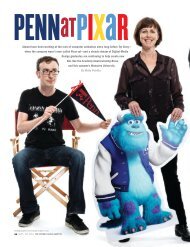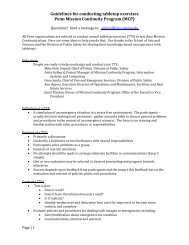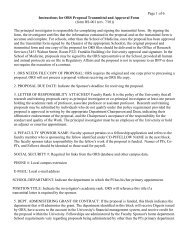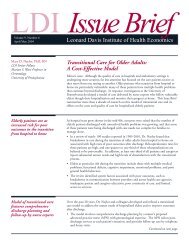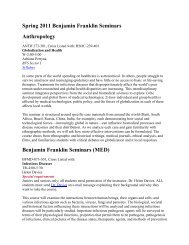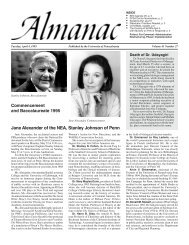No. 3 September 13, 1994 - University of Pennsylvania
No. 3 September 13, 1994 - University of Pennsylvania
No. 3 September 13, 1994 - University of Pennsylvania
- No tags were found...
Create successful ePaper yourself
Turn your PDF publications into a flip-book with our unique Google optimized e-Paper software.
In a new Freshman Convocation tradition, students from this year’s 2353-member entering class marched down Locust Walkin the academic procession with deans and faculty, staff and trustees, who cheered them as they entered Irvine Auditoriumfor songs and ceremony led by the also-incoming president and provost. (See their addresses below.) Standard-bearersin the academic procession were Dean <strong>of</strong> Admissions Lee Stetson, Acting VPUL Valarie Swain-Cade McCoullum, andGeneral Alumni Society President John Reardon. During the Convocation, Senior Class President Loren Mendellpresented the Class <strong>of</strong> ’98 with its own flag.Members <strong>of</strong> the Class <strong>of</strong> 1998: Welcome by Judith RodinI am a member <strong>of</strong> the class <strong>of</strong> 1966, so 32 years ago I sat where yousit, I feared what you fear, and imagined pretty much the same things youimagine. And I remember thinking: Is this place going to measure up tomy expectations, was all the hard work and sacrifice worth it? And to betruly honest, I worried about whether I would measure up.Those recollections are especially strong tonight as I welcome youbecause I am again a freshman at Penn, and therefore you and I share aspecial bond. We are entering this university in <strong>1994</strong> and together we aresetting <strong>of</strong>f on a journey that will irrevocably change each <strong>of</strong> us.We start <strong>of</strong>f with much in common. We share a sense <strong>of</strong> pride that aninstitution as outstanding as the <strong>University</strong> <strong>of</strong> <strong>Pennsylvania</strong> chose us to bemembers <strong>of</strong> its community. We begin as well with a common sense <strong>of</strong> determination:to meet the challenges that await us and to fulfill the goals wehave set for ourselves. And we begin with a tremendous sense <strong>of</strong> excitement,a feeling <strong>of</strong> great anticipation <strong>of</strong> all that lies ahead: the many people we willmeet here who will enrich us, the distinguished scholars we will learn from,and the traditions and rituals that will become a part <strong>of</strong> us.It is fitting that we set <strong>of</strong>f on our journey together from the site <strong>of</strong> thisparticular campus shrine, Irvine Auditorium. Its history is an interestingone, with a message that is instructive today. Irvine Auditorium was builtin 1926, designed in large part by Julian Francis Abele, one <strong>of</strong> the firstblack graduates <strong>of</strong> our own School <strong>of</strong> Architecture. It was conceived in thespirit <strong>of</strong> Medieval France, but because <strong>of</strong> limited finances, its outcome ishighly eclectic. It had to be constructed <strong>of</strong> brick, not stone. To compensate,perhaps, its exterior was adorned with a wonderful assortment <strong>of</strong> spires andturrets, arches and gargoyles. The small plot <strong>of</strong> land available for the sitealso meant that there would be no room for the grand nave <strong>of</strong> the Frenchcathedral. The architects had to be content instead to go high, giving usthis sloping ro<strong>of</strong> that soars to a height <strong>of</strong> 200 feet, and this majestic auditorium—theperfect home for one <strong>of</strong> the world’s largest organs, whichwe have been privileged to listen to this evening.Irvine Auditorium is a metaphor for much that is important about thespirit <strong>of</strong> Penn. This is a university that recognizes that constraints andlimitations represent challenges and opportunities, inviting invention andcreativity. It is also a place that appreciates eclecticism and diversity, knowingthat a variety <strong>of</strong> cultural and intellectual styles can happily coexist.Because I feel a special bond to this entering class, I wanted to learn moreabout you as we set <strong>of</strong>f together. I wanted to know who you are and whatyour aspirations are and what drew you to Penn. I was impressed by whatI learned. You survived one <strong>of</strong> the most competitive admissions’ processesin this university’s history, and your success was due to your outstandingcredentials and backgrounds. One quarter <strong>of</strong> you, I learned, have held significantleadership positions in your high school government, 235 <strong>of</strong> youwere editors-in-chief <strong>of</strong> high school publications, 863 <strong>of</strong> you are exceptionalathletes, with 22 world class or Olympic hopefuls. Some 474 <strong>of</strong> you havebeen involved in music and the performing arts and over 200 worked at leastpart-time in your school years, 40 operating your own businesses.You come from every state in the union, with the exception <strong>of</strong> <strong>No</strong>rthand South Dakota (Dean Stetson, we need to correct that next year)—some<strong>of</strong> you from as far away as Africa, the Middle East, Asia, the PacificIslands, Australia, Europe, the Americas, Mexico, and Canada. You alsobring with you a wonderful ethnic diversity. A third <strong>of</strong> you come fromminority backgrounds, including African Americans, Hispanics, Asian,and Native American. Forty-nine percent <strong>of</strong> you—the highest percentageever—are women.But more than the statistics, it is your words that I was most struck byas I read over the essays you prepared for your admissions applications.Listen to how two <strong>of</strong> your classmates described why they were drawnto Penn. First, Ernest:“You’re a chameleon,” my friend asserted accusingly.He was right—I did change when I talked to different people.Sometimes I talked urban lingo, and other times I had politeness writtenall over the hands that opened doors and carried books for others.Sometimes I like to think about things until it hurts to think. I enjoydancing up a storm and getting coated in poster paints while decoratingfor Key Club.And this is why I know we’ll get along, Penn is the perfect environmentfor a chameleon like me because it allows me to continue changing.Yes, as in any good college, I can find both Nietzsche neophytesand party practitioners, but it is more than that. Penn as an institutionshows its duality—its ability to be two types <strong>of</strong> schools. Although Ithought college should be either a liberal arts school for the “thinkers”or a pr<strong>of</strong>essional school for the “workers,” Penn is neither, or ratherPenn is both. This is a chameleon college education, and why, just asthe ability to adapt to all things is crucial to the identity <strong>of</strong> a chameleon,the ability to be all things is classic to Penn.And now, Matthew’s words:So why is Penn right for me? After listening to Amy Calhoun’s description<strong>of</strong> the <strong>University</strong>, I received the impression that Penn was thebad boy <strong>of</strong> the Ivy League—the place where not only brains, but thoughtand creativity are prevalent. Hardly a day goes by that I’m not debating aphilosophical point with my English teacher or smiling with my physicsteacher as he does push-ups in front <strong>of</strong> the class because <strong>of</strong> a bet I wonwith him. The previous day we had been debating whether his model cartdemonstrated uniform acceleration or constant velocity. Since the debatewas getting us nowhere fast, I ended our discussion by simply saying, ‘I’lldo five push-ups in front <strong>of</strong> the class if I’m wrong as long as you’ll do thesame.’ He started to object, so I said, “Don’t worry! The student rule bookdoesn’t say anything against betting between students and teachers.”It is that kind <strong>of</strong> energy that I hope to bring to Penn. <strong>No</strong>, I’m notplanning to start a personal exercise program for my pr<strong>of</strong>s. Based solelyon academic bets. I do hope, however, to enter a pool <strong>of</strong> thought thatcan give buoyancy to my convictions.Diverse in my outlooks, active, and a firm believer that the mindcan dull only through lack <strong>of</strong> use, I should be a proper match with aschool that has such merits as “the school with the highest number <strong>of</strong>students applying for patents” to its credit.Reading over essays like these, I was once again taken back to the time when Isat in your place as a freshman. I came from only ten miles away, but it didn’tmatter. When I left high school and entered this university, I knew that I hadcrossed over a vast divide, just as surely as if I had come from Houston orCleveland or Taiwan. There was a distinctive character to this university thatdrew me here those many years ago and which has lured me back in <strong>1994</strong>—aquality which I believe has drawn you to this remarkable place as well.Part <strong>of</strong> Penn’s character came, then and now, from being one <strong>of</strong> thiscountry’s foremost research institutions. You will share my pride, I know,in coming to a university where medical scientists like James Wilson aregaining worldwide attention for putting basic gene research to work to curedevastating diseases like cystic fibrosis...where ethnographers like ElijiahAnderson are probing the inner city code <strong>of</strong> the streets to try to understandthe origin <strong>of</strong> youth violence...where communication experts like KathleenHall Jamieson are discovering how public policy debates are influencedby network news coverage and the expenditure <strong>of</strong> millions <strong>of</strong> dollars inpolitical advertising. I am excited to be a part <strong>of</strong> a university where cuttingedge discoveries are being made every day, and where the results are <strong>of</strong>great importance to basic knowledge, public health and human welfare.Another part <strong>of</strong> what makes Penn so exciting comes from our location,being smack in the middle <strong>of</strong> a big city. <strong>No</strong>w for many people, I know,urban location is a minus, not a plus. For many people, cities are places tobe avoided at all costs; but for me, and I suspect for most <strong>of</strong> you, the factthat Penn lies in the very heart <strong>of</strong> the city <strong>of</strong> Philadelphia was a major part<strong>of</strong> its attraction. Cities have always been places <strong>of</strong> excitement and action,Almanac <strong>September</strong> <strong>13</strong>, <strong>1994</strong>



